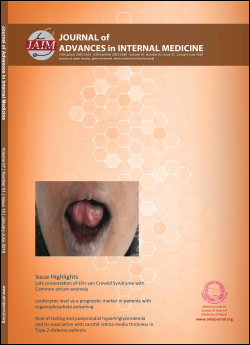Iron Deficiency Anemia: A profile of a tertiary care hospital
DOI:
https://doi.org/10.3126/jaim.v7i1.19575Keywords:
Iron deficiency anemia, Moderate anemia, nutrition, NepalAbstract
Background and aim: Iron deficiency refers to the reduction of iron stores that precedes overt iron deficiency anemia. Iron deficiency anemia (IDA) is the commonest nutritional deficiency around the globe. Though etiology of IDA is multifaceted, and results from the iron demands which is not met by iron absorption in the body, regardless of the reason. This study was aimed to observe the several hematologic parameters among IDA cases presented to a tertiary level referral hospital of Nepal army.
Methods: This prospective hospital based study was conducted among cases of iron deficiency anemia presented to a hematology clinic for six-month duration. With the help of semi-structured questionnaire demographic variables, presenting complaints, baseline laboratory parameters, iron profile and etiology of iron deficiency anemia were recorded. The collected data were entered in SPSS version 22 and analyzed.
Results: In the six-month study period, there were 175 IDA cases who presented to hematology clinic. IDA was more common in females accounting 78% of 175 cases while rest were male. Mean value of parameters of iron profile were all significantly lower than normal range except TIBC which was significantly raised clinching the diagnosis of IDA. Weakness was the commonest mode of presentation (83, 47.4%). Poor intake was the main culprit of IDA (88, 50.3%). Most of the cases (82, 46.9%) belonged to moderate anemia group. Severity of anemia was associated with platelet count and total leucocyte count (p<0.05) while it was not associated with iron profile values (p>0.05).
Conclusion: In adult group, IDA is more common in women and non-specific symptoms like weakness is the commonest mode of presentation. Poor dietary intake is the main cause of IDA in our context. Among IDA cases, most of them belonged to moderate anemia.
Downloads
Downloads
Published
How to Cite
Issue
Section
License
This license enables reusers to distribute, remix, adapt, and build upon the material in any medium or format, so long as attribution is given to the creator.




